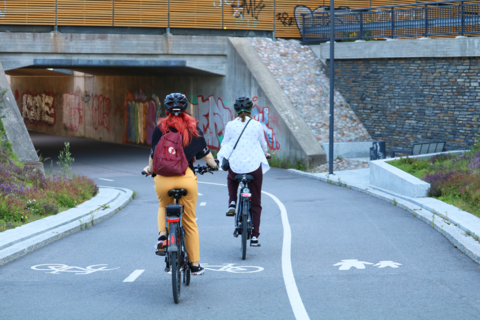Pilot project produces local weather information for cyclists – developers hope for a cold winter for testing the service

Is it safe to cycle to work today without studded tyres? Have the cycle paths been ploughed or would it be better to not commute by bicycle today? Weather sensors were installed at five different locations in Espoo during the summer. Now they collect superlocal data on weather conditions. The sensors and weather stations provide accurate and up-to-date information on road conditions for Maintenance Services and regular road users. Now the developers are hoping for a cold winter so that they can test the sensors in authentic conditions.
The circular weather sensors on the ground are the size of a one-cent coin and almost undetectable. The weather stations on lamp posts are less hidden, but equally unproblematic for traffic. In autumn 2025 and winter 2026, these devices, installed at five locations in Espoo, produce superlocal traffic weather forecasts for residents and for the city's Maintenance Services. The sensors and weather stations allow for up-to-date information on weather conditions, i.e. temperature and humidity on the road. The information is updated approximately once an hour to an open website(external link, opens in a new window).
”We hope to combine the real-time data with feedback from users. This could give us a new perspective for assessing the level of maintenance and thereby improve the city’s ability to react rapidly to changing conditions,” Maintenance Manager Pekka Pakkala from the City of Espoo explains.
The weather sensors are being tested at five locations that were selected in cooperation with experts from the Maintenance Services of the City of Espoo. Three of the sites are on routes that connect to enhanced winter maintenance routes. The remaining two sites are on a route with enhanced maintenance and act as a point of reference. Enhanced winter maintenance routes are swept and salted daily before commuting traffic begins. As such, they ought to be in good cycling condition every day. However, people are nonetheless known to have some uncertainties regarding the conditions of swept and salted routes during cold and snowy weather.
”The goal is to help residents prepare for upcoming weather conditions in the morning by giving them up-to-date information on local conditions, such as the risk of cycling routes being frozen,” explains Jaakko Melamies from Mellenium Oy, the company carrying out the pilot. ”In addition to updates on the website, the information is automatically highlighted on the service’s Facebook page every morning. People can also use the Facebook page for discussing and giving feedback on the service.”
The pilot aims to increase commuting by bicycle in the more challenging winter conditions.
The weather sensors and road weather service used in the pilot are made by the Estonian company Teede Tehnokeskus. The road weather service has already been used for motor traffic and is now utilised for the first time to produce data for cyclists and pedestrians.
Data on weather and road conditions is important in creating a sense of safety and encouraging people to walk and cycle. Despite this, such information is not provided for cyclists as much as it is for motor traffic. The pilot aims to provide up-to-date information on weather and road conditions, thus helping users to be prepared and promoting effortless and safe year-round walking and cycling.
”We are testing traffic weather sensors in Espoo for the first time. The pilot project is also about learning – we collect feedback and use it to further develop the service,” explains City of Espoo’s Senior Specialist Tessa Armour, who is responsible for the Pilot Program.
The weather data pilot is part of the Sustainable Future Districts Pilot Program. The program’s pilots began in spring 2025 and will end in March 2026 at the latest.